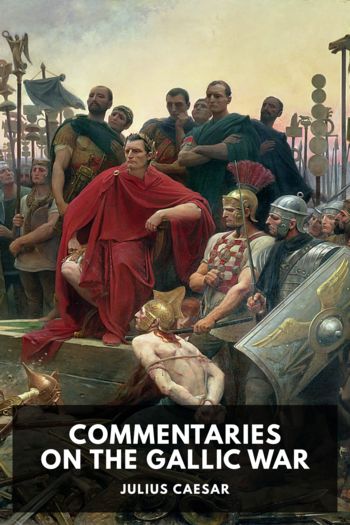Fateful Lightning: A New History of the Civil War & Reconstruction by Allen Guelzo (icecream ebook reader txt) 📗

- Author: Allen Guelzo
Book online «Fateful Lightning: A New History of the Civil War & Reconstruction by Allen Guelzo (icecream ebook reader txt) 📗». Author Allen Guelzo
On good, new Mississippi valley soils, there were immense profits to be made, and Romantic paternalism be damned. Harriet Martineau toured cotton plantations in Alabama in the mid-1830s where the profit margin was 35 percent. “One planter whom I knew had bought fifteen thousand dollars’ worth of land within two years. … He expected to make, that season, fifty or sixty thousand dollars of his growing crop.” Joseph H. Ingraham in 1835 had met raw new cotton planters in southwestern Mississippi with net annual incomes between $20,000 and $40,000. Making the adroit move to the most advantageous location could generate immense and quick wealth in cotton. The cotton crop could gross $74 million per annum in the 1840s; a decade later, it would sell for $169 million, and between 1856 and 1860, it topped $207 million a year. In 1860, half of the ten wealthiest states in the Union were slave states, and six of the top ten in terms of per capita wealth were slave states; calculated solely on the basis of the wealth of white inhabitants, eight of the top ten wealthiest states in the Union were slave states. The single wealthiest county in the United States, in terms of per capita wealth, was Adams County, Mississippi. It was ambitious Alabama and Mississippi planters, and not avaricious Northern factory owners, that Martineau described as being, “from whatever motive, money-getters; and few but money-getting qualifications are to be looked for in them.” Slave owners might preen themselves upon their gentry manners, but they had no objection at all to making handsome profits.61
In this environment, slave owners proved to be quite as grasping as their despised Yankee counterparts. “Us was same as brutes en cows back dere,” remembered a South Carolina slave years later. “Dey would beat de colored people so worser till dey would run away en stay in de swamp to save dey hide.” Because “I was black it was believed I had no soul,” wrote William Henry Singleton; “in the eyes of the law I was but a thing.” The signposts of the slave’s life were “the steel shackles of slavery, the slave block of the market place where husbands and wives, parents and children, were ruthlessly torn apart and scattered asunder, the whipping post, the slave quarters, the inhuman restrictions, such as denial of our own religious privileges, no ministers or churches of our race, no educational advantages to speak of, no social freedom among ourselves. …” Slavery was nothing but “jest a murdering of de people.”62
So slaves rebelled when they could, as Denmark Vesey and his conspirators tried to do in Charleston in 1822, and as Nat Turner and his band of slaves actually did in Virginia in 1831. When outright rebellion was impossible, slaves found other ways to isolate and terrify their tormentors, including work slowdowns, breakage of tools, and abuse of work animals. Frederick Law Olmsted was told by one slave mistress, “There is hardly one of our servants that can be trusted to do the simplest work without being stood over. If I order a room to be cleaned, or a fire to be made in a distant chamber, I never can be sure I am obeyed unless I go there and see for myself. … They never will do any work if you don’t compel them.” Some slaves fought back: when James Knox Polk’s overseer, John L. Garner, tried to make “Henry, Gilbert, and charls” less “indifferent” about their “duty,” one of them “resisted and fought mee.” 63
And they ran away. Sometimes for short periods of time to evade punishments, sometimes to escape from slavery entirely, the slaves ran whenever the threats or the opportunities became too great to resist. When Josiah Henson’s master moved him from Maryland to a new plantation down the Ohio River in 1830 and then began toying with the idea of selling Henson away from his wife and children, Henson “determined to make my escape to Canada, about which I had heard something, as beyond the limits of the United States.” In mid-September 1830 he arranged to collect his wife and children, persuaded a fellow slave to ferry them over the Ohio River by night, and trudged all the way to Canada on foot.64
Frederick Bailey returned to his master, scheming all the while how to buy his freedom with the money he earned on odd jobs performed for other whites. But when his master suspended his outside work privileges, Bailey decided that he had paid his master all he deserved, and in 1838 he boarded a train headed for Philadelphia, dressed as a sailor and carrying false identification papers. He found his way to New Bedford, Massachusetts, where he changed his name to Frederick Douglass. In 1841, Douglass was recruited as an agent for the Massachusetts Anti-Slavery Society; four years later he published his Narrative of the Life of Frederick Douglass, an American Slave. Within a decade he had become the most famous African American on the continent, and one of slavery’s deadliest enemies.65
If slave owners worried about the misbehavior of their slaves, they experienced just as much anxiety over non-slaveholding whites. Although slaves were held by a remarkably broad section of Southern society—overall, one out of every four white families in the South in 1860 owned slaves, an extraordinary figure when it is remembered that by 1860 the cost of a strong, healthy field hand had reached $1,500—the distribution of that ownership varied considerably. Less than 1 percent of Southern white families (comprising a group of less than 12,000 people across the South) owned more than a hundred slaves,





Comments (0)